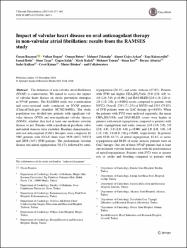Impact of valvular heart disease on oral anticoagulant therapy in non-valvular atrial fibrillation: results from the RAMSES study

View/
Date
2017Author
Başaran, ÖzcanDoğan, Volkan
Beton, Osman
Tekinalp, Mehmet
Aykan, Ahmet Çagrı
Kalaycıoğlu, Ezgi
Biteker, Murat
Metadata
Show full item recordAbstract
The definition of non-valvular atrial fibrillation (NVAF) is controversial. We aimed to assess the impact of valvular heart disease on stroke prevention strategies in NVAF patients. The RAMSES study was a multicenter and cross-sectional study conducted on NVAF patients (ClinicalTrials.gov identifier NCT02344901). The study population was divided into patients with significant valvular disease (SVD) and non-significant valvular disease (NSVD), whether they had at least one moderate valvular disease or not. Patients with a mechanical prosthetic valve and mitral stenosis were excluded. Baseline characteristics and oral anticoagulant (OAC) therapies were compared. In 5987 patients with NVAF, there were 3929 (66%) NSVD and 2058 (34%) SVD patients. The predominant valvular disease was mitral regurgitation (58.1%), followed by aortic regurgitation (24.1%) and aortic stenosis (17.8%). Patients with SVD had higher CHA(2)DS(2)VASc [3.0 (2.0; 4.0) vs. 4.0 (2.0; 5.0), p < 0.001] and HAS-BLED [2.0 (1.0; 2.0) vs. 2.0 (1.0; 2.0), p = 0.004] scores compared to patients with NSVD. Overall, 2763 (71.2%) of NSVD and 1515 (73.8%) of SVD patients were on OAC therapy (p = 0.035). When the patients with SVD were analyzed separately, the mean CHA(2)DS(2)VASc and HAS-BLED scores were higher in patients with mitral regurgitation compared to patients with aortic regurgitation and aortic stenosis [4.0 (3.0; 5.0), 3.0 (2.0; 4.0), 3.0 (2.0; 4.0) p < 0.001 and 2.0 (1.0; 3.0), 1.0 (1.0; 2.0), 1.0 (0.0; 2.0) p < 0.001, respectively]. In patients with SVD, 65.7% of mitral regurgitation, 82.6% of aortic regurgitation and 88.0% of aortic stenosis patients were on OAC therapy. One out of three NVAF patients had at least one moderate valvular heart disease with the predominance of mitral regurgitation. Patients with SVD were at greater risk of stroke and bleeding compared to patients with NSVD. Although patients with mitral regurgitation should be given more aggressive anticoagulant therapy due to their higher risk of stroke, they are undertreated compared to patients with aortic valve diseases.

















